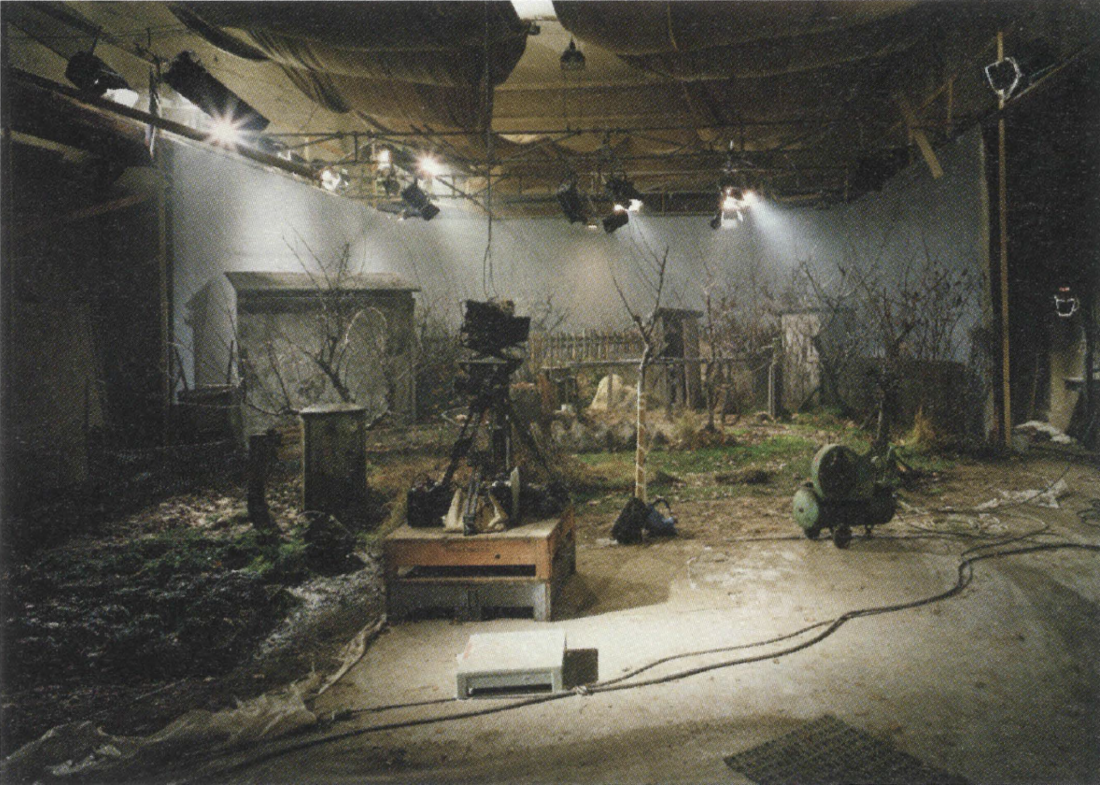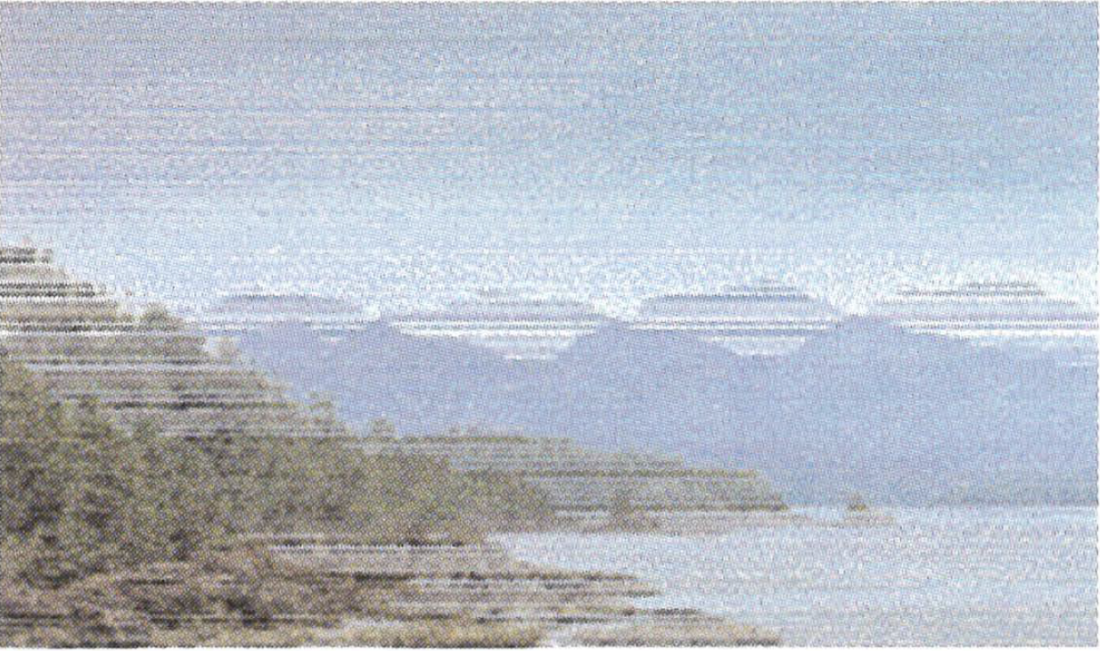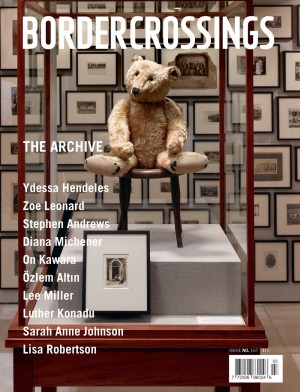The Pleasure of Confoundment
Whether making art or speaking about it, Stan Douglas comes across as serious, thoughtful and immensely well read. There is never any doubt about the thoroughness of the research that serves as the foundation for his film and video projections, nor about the ability of his mind and eye to synthesize complex images and difficult concepts. Literate, articulate and considered as Douglas is, however, some of his words have come back to haunt him. Some have come back repeatedly. In a 1993 interview with Lynne Cooke in Frieze, Douglas stated that he was “preoccupied with failed utopias and obsolete technologies.” This quote seems to have lodged in our ages critical consciousness of Douglas’s work, recurring in subsequent articles, profiles and reviews, and on the lips of senior curators and museum educators. Its been used to explain what it is Douglas does, to elucidate the social, cultural, media and political subjects he weaves into his art practice. Since his graduation from art school in Vancouver in the early 1980s, Douglas has produced art of increasing technical sophistication and intellectual complexity. And he has loaded that art with a considerable weight of historical references—references that are both intriguing and arcane.
More recent versions of the quote about failed utopias and obsolete technologies pop up in the Vancouver Art Gallery’s catalogue to its Stan Douglas exhibition, and in a substantial monograph on Douglas, published last fall by Phaidon as part of its Contemporary Artists series. (Among those featured in this prestigious series are Christian Boltanski, Mona Hatoum, llya Kabakov, Mary Kelly, Nancy Spero and Vancouver’s other international art star, Jeff Wall.) Both publications are so handsomely designed and authoritatively composed, so assured in the delivery of their content, that the reader naturally believes everything that is printed in them. The artist, however, does not. He has repudiated his own words, revised his own understanding of what his project was—and is.
“I had misconstrued what I was doing,” Douglas told me when I brought up the quote in a pre-exhibition, post-book interview. “I was chronicling the absence of modernist tensions in the postwar period, I suppose, in a lot of those pieces—in Ruskin, in Hors-champs, in Evening especially.” The failed utopias he once spoke about “were not necessarily positive ones.” Products of the time and culture in which they were first proposed, they enfolded within them certain ugly prejudices, certain exclusions of class and race. Their ideals would have been utopian only for a privileged few.
Irrespective of his revisionist reading of his own oeuvre, Douglas’s recent work continues to examine the aspirations, optimisms and ideologies of the modern age (and earlier)—and to reflect on the, well, failures of certain key “moments”—whether those moments were technological or ideological—to fulfil their promise, to deliver a condition of social or cultural betterment into the postmodern era. Daina Augaitis, the curator who organized the Vancouver Art Gallery show, writes in the catalogue that “Stan Douglas uses the narrative form to grapple with the legacies of modernism, casting doubt on the utopian dreams that have accompanied it.” Critiquing and deconstructing modernism (ditto colonialism, another theme manifest here) are hardly novel enterprises in contemporary art—but Douglas brings his own distinct readings and dramatic strategies to the practice, his own unique vision and facility.
“You study the past to understand why things are the way they are today,” Douglas told me, “and in doing so you realize certain possibilities that were not fulfilled.” In the VAG exhibition, Douglas’s studies of the past cover a number of cultures, sites and eras: 18th-century conflicts among European imperialists on the west coast of Vancouver Island (Nut﹡ka﹡); the nature of allotment gardens in Germany from the early 19th century through the fall of the Berlin Wall (Der Sandmann); the exodus of Afro-American jazz musicians from the United States to Paris in the mid-20th century and the association between the “Free Jazz” movement and the 1968 student protests in France (Horschamps); and the attitudes of modernist city planners towards “urban blight” in Vancouver in the 1950s and ’60s (Win, Place or Show).

Stan Douglas, Historic Set for Der Sandmann at DOKFILM Studios, 1995, colour photograph. Photographs courtesy Vancouver Art Gallery.
Each of these works has a much more complex theme, structure and narrative than the above summary can convey. Each also has somewhat abstruse allusions. For those who cannot afford the catalogue or monograph as a guide to Douglas’s work, the VAG has provided copies (in the form of didactic panels and a 17-page brochure) of Douglas’s own descriptions of the works’ historical backgrounds. For those who can afford the big, glossy publications, critical and curatorial interpretations abound, mostly—and blessedly—written without the obfuscations of artspeak or post-structuralist theory.
The well-illustrated catalogue includes essays by Augaitis, George Wagner and William Wood; the equally good-looking Phaidon book includes interviews with Lynn Cooke and Diana Thater, and essays by Carol Clover, Scott Watson and Gilles Deleuze (the latter, “Humour, Irony and the Law,” chosen by the artist rather than written about him); and both publications feature Douglas’s own clear and insightful writings on his subjects. Still, all the verbal support and explanation beg the question of how much is conveyed by Douglas’s film and video works alone.
The answer, I think, is a lot—but the experience of this art is not nailed to particular facts or concepts, nor is it necessarily pinned to Douglas’s reading of history, media and culture. There is an undeniable visual and aural quality to Douglas’s work that compels our attention, even while the content may puzzle or confound us. Nut﹡ka﹡, for example, entices viewers with panning shots of Nootka Sound, a place of great natural beauty and (apparent) serenity. It also seduces its audience with its quadrophonic soundtrack, on which the voices of two actors overlap and interweave to create a rushing sound, like the wind through fir trees or waves on a rocky shore.
The two discrete image tracks, rotating in opposite directions, are interlaced on even and odd raster lines of the same composite screen, that is, they are two separate, incomplete and discrepant versions of the same landscape. Only occasionally do they come together to create one complete and sharply resolved image. Then they split apart again, lapsing into abstraction and alienation. As the visual images synchronize, so do the aural: the two competing monologues unite briefly in a single recitation of the narrative, then separate into competition and confusion. Where the narratives fuse is in a shared paranoia, a sense of the uncanny, a fear and apprehension of the deep, dark, alien forest and of deep, dark, alien humanity, characterized here as criminal and degenerate or just plain insane. Unfortunately, there is a frustrating sense throughout this work that the actors are reading their lines much too quickly. However successfully Douglas achieves an impressionist tone-poem quality in his soundtrack and however skillfully he meshes image to text, it is difficult to understand and reflect upon what either man is saying, even when they’re speaking the same words at the same time.
Douglas’s references here are to an actual historic confrontation, in 1789, between English and Spanish ship captains at Nootka Sound, and he draws some of the script from archival materials—journals and other historic documents. He also alludes to romantic concepts of the sublime, and to gothic and colonial literature, from which quotations are borrowed. Douglas is interested, it seems, in the ways in which writers such as Edgar Allen Poe, Miguel de Cervantes and Jonathan Swift responded to the imperialism of the times in which they lived. Gothic literature, particularly, is said by Douglas to reveal European attitudes towards the aboriginal peoples they were encountering in the distant lands. As for the aboriginal peoples themselves, they are present in Douglas’s video projection only through their conspicuous absence (that ol’ postmodern paradox). Just as British and Spanish explorers, traders and colonizers excluded northwest coast Natives from title to the lands they had long inhabited (and to which the newcomers were laying guilt-free claim, as if the Natives didn’t exist), so Native voice and presence are intentionally absent from Nut﹡ka﹡.

Stan Douglas, Nut﹡ka﹡, 1996, video still.
Augaitis writes that Douglas “destabilizes” his subjects, provoking questions rather than providing answers. She lauds his evocation of small, significant moments in history, as opposed to blindly subscribing to the “grand” or master narratives. And she cites the tools—paradox, ambiguity, multiple viewpoints—by which he tells his stories. A frequent strategy of Douglas’s (although one he now describes as “a bad habit”) is the use of binary constructions. Through split screens, double screens or single screens with double projections (either front and back or overlapping), he has formally integrated the concept of dialectic—the notion of thesis and antithesis without which synthesis is impossible—into his work. He has also, through his simultaneous but diverging or disjunct viewpoints, communicated the impossibility of a single or unified take on any historic subject or experience. “With the number two you’re able to have harmony, dissonance, conflict, all those things,” says Douglas, explaining his (former) attachment to binary structures. “It’s the lowest number at which you can start to have polyphony happening.”
In addition to the four large-scale installations, the exhibition and both books demonstrate Douglas’s deftness as a still photographer. (Douglas majored in photography at art school and only learned film and video techniques after graduating.) In the beginning stages of a major film or video project, he uses his still camera to investigate a site and come to some understanding about its social, cultural, geographical and historical significance. Douglas’s photos often contain direct representations of subjects to which his film and video projects only indirectly, invisibly or obliquely allude. For instance, the chromogenic prints he took in the Nootka Sound area before making Nut﹡ka﹡ document clear cuts, logging roads and lumber mills, along with Native fish traps and petroglyphs—none of which appear in the video projection itself. (Too explicit, one supposes, yet the photos add a significant resonance to our experience of the film or video.)
Douglas’s photographs are beautifully and soberly composed, filled with poetic detail and rich but subtle colour. They could exist quite successfully within a formalist/modernist context—except for the postmodern critiques enfolded in them. (Eliot Porter’s photographs come to mind when looking at Douglas’s Spanish Well at Yuquot or Marble Quarry at Hisnit Inlet but, to the best of my knowledge, Eliot Porter does not interest himself in industrial sites, like Tahsis Mill or Gold River Mill.)
As with the work of fellow Vancouverite Jeff Wall, Douglas’s film and video projections involve expensive, lengthy, feature-film-like preparations, production and postproduction, including script-writing, art direction (you can’t help but notice the B.C. Binning painting, borrowed from a local public collection and mounted on the wall of the claustrophobic apartment set of Win, Place or Show), set-building, location shooting, casting and directing, editing, sound mixing, etc. Given the feature-film similarities, and Douglas’s apparent fondness for cinematic narrative and storytelling, it’s interesting that he chooses to exhibit in the context of an art gallery or museum rather than in a cinema.
It’s likely, Douglas suggests, that gallery-going audiences would be more willing to work at what they’re viewing than movie-going audiences. (And audiences in Europe, where both Wall and Douglas are highly regarded and widely exhibited, are apparently more willing to persevere than those in North America.) An art gallery setting enables Douglas to produce work with much greater technical and intellectual complexity, and more challenging “presentational technologies” than the conventions of the movie theatre would allow.
Having previewed Douglas’s works on a video monitor, before they’d been installed at the VAG, I can attest to the dramatic transformation that occurs when they are enlarged through projection in a white-walled gallery. Because of their large scale and “presentational technologies,” they make an almost indescribable leap—from the ho-hum to the spectacular. It’s the spectacularity of Douglas’s film and video projections, together with the intelligence that resonates through and from them, that compels our repeated viewing. Much more is going on in Douglas’s works than most of us will ever understand, but still, it’s a pleasure to be confounded in just this way ♦
“Stan Douglas” is at the Vancouver Art Gallery through May 25, 1999. It then travels to the Edmonton Art Gallery (June 25 to August 24, 1999); Power Plant in Toronto (September 24 to November 21, 1999); De Pont in Tilberg, the Netherlands (February 5 to May 28, 2000); and The Museum of Contemporary Art in Los Angeles (December 10, 2000 to April 1, 2001).
Stan Douglas Vancouver, The Vancouver Art Gallery, 1999 Hardcover, 134 pps., $45.00
Stan Douglas London, Phaidon Press, 1998 Softcover, 160 pps., $39.95
Robin Laurence is Border Crossings’ Contributing Editor in Vancouver.

